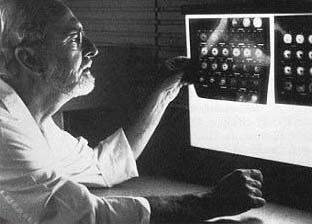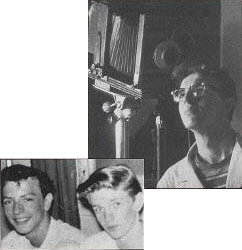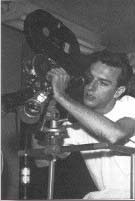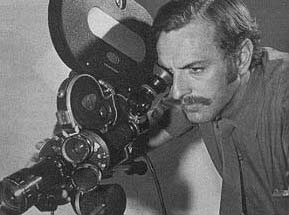An Interview with Johnny Justice, Jr.Originally published in The Journal of Ophthalmic Photography In 1994, the Ophthalmic Photographers' Society celebrated it's 25th anniversary. To commemorate that event, an interview with the principal founder of the OPS was conducted by the editor of the Journal of Ophthalmic Photography, Richard Hackel, and published in the 25th anniversary issue in October, 1994. This is an edited version of the original publication. ....Leonard Hart had taken over as chief of photography at the Durham VA Hospital. He offered me a job as assistant chief, and I accepted. Leonard had brought with him the Bausch & Lomb fundus camera that he had modified at the Chicago VA Hospital. Dr. Noble J. David had interested Leonard in attempting to duplicate Novotny and Alvis' success in retinal angiography and after placing the Kodak Wratten filters into the modified instrument, their first attempt was a success. To my knowledge, that angiogram was the second successful fluorescein study.
As time went by, more and more talented photographers began to come out of the woodwork. Sgt. Terry Tomer, fresh out of photography in the U.S. Army, came to Miami to train in this field. At that time, the Biological Photographic Association was the only society that was oriented toward medical photography. Unfortunately, there was little information on eye photography. The idea of an alternative was beginning to germinate.
Don Wong came to Miami to observe our techniques. His visit began a long and competitive friendship that set the stage for my discussions with Earl, Don and Terry about starting our own society. In April of 1969, we met with Lee Allen at the ARVO meeting in Sarasota, Florida and we agreed to have our first meeting at the Palmer House in Chicago on October 15, 1969. In attendance at this meeting were Lee Allen, Earl Choromokos, Ogden Frazier, Johnny Justice, Yvonne Magli, Mary Manella, Terry Tomer, Anna Wiley, Don Wong, and Roger Lancaster who is now deceased. Following input from others in attendance, I nominated Lee Allen and he was unanimously elected Interim-President of the OPS. Lee then appointed me Interim-Secretary-Treasurer and Program Chairman until the society had its first formal election of officers. If my memory serves me correctly, it was at this meeting we decided that we would refer to ourselves as ophthalmic photographers, and that the organization would be called The Ophthalmic Photographers' Society. At a later meeting in Miami on March 6, 1969, Don Wong was appointed Interim-Vice-President. On July 13, 1970, the OPS became a formal reality. Without the extraordinary help and enthusiasm of my secretary, Jessica (Pixie) Eichrodt, the understanding and support of Dr. Edward W.D. Norton, and especially without the constant prodding of Don Wong, this society may never have become a reality. In 1971, I accepted a faculty appointment at Baylor College of Medicine in Houston, Texas. My proudest achievement during my ten years at Baylor was that the original and revised issues of Ophthalmic Photography were published by Little, Brown, and Company. I am sure you will agree that for the most part, fate has been kind to Johnny Justice, Jr. and to the Ophthalmic Photographers' Society. I would like to express my appreciation to Richard Hackel, current Editor of the OPS Journal for suggesting this interview.

|

 After a few more of these studies, Leonard taught me how to do them. I did angiograms until I left North Carolina for Miami, Florida in December 1962. Leonard Hart and Raymond Howard of the Duke Photography Department had both turned down Dr. Norton's offer to work at the Bascom Palmer Eye Institute. I was his third choice. On January 3, 1963, I officially became a full-time eye photographer. Drs. Edward W.D. Norton, J. Lawton Smith, and Victor T. Curtin began referring essentially every case that had some retinal or choroidal pathology for angiography. Approximately six months later, Dr. J. Donald M. Gass arrived and became immediately interested in fluorescein angiography as his record clearly shows.
After a few more of these studies, Leonard taught me how to do them. I did angiograms until I left North Carolina for Miami, Florida in December 1962. Leonard Hart and Raymond Howard of the Duke Photography Department had both turned down Dr. Norton's offer to work at the Bascom Palmer Eye Institute. I was his third choice. On January 3, 1963, I officially became a full-time eye photographer. Drs. Edward W.D. Norton, J. Lawton Smith, and Victor T. Curtin began referring essentially every case that had some retinal or choroidal pathology for angiography. Approximately six months later, Dr. J. Donald M. Gass arrived and became immediately interested in fluorescein angiography as his record clearly shows.  On several occasions, Dr. Norton spoke of Lee Allen, an artist-ocularist who also enjoyed a wonderful reputation for his eye photography. I contacted him and informed him of our work, and I asked him about stereo fundus photography. He sent me a copy of his not yet published manuscript, but now classic article, "Ocular Fundus Photography" which included his technique of stereo photography. Years later, I found out that John Goeller and Don Wong of New York, not yet involved in fluorescein angiography, had been taking fundus photos and external photos for academic eye departments for quite some time.
On several occasions, Dr. Norton spoke of Lee Allen, an artist-ocularist who also enjoyed a wonderful reputation for his eye photography. I contacted him and informed him of our work, and I asked him about stereo fundus photography. He sent me a copy of his not yet published manuscript, but now classic article, "Ocular Fundus Photography" which included his technique of stereo photography. Years later, I found out that John Goeller and Don Wong of New York, not yet involved in fluorescein angiography, had been taking fundus photos and external photos for academic eye departments for quite some time.  In 1968, I met Earl Choromokos, a research photographer with Dr. Noble J. David. About that time, Don Wong called from New York to introduce himself. His professor, Dr. Irving Leopold, was really upset hat he was going to the annual BPA meeting. He told me that Dr. Leopold said, "Go to Miami to learn from Johnny Justice and then attend the annual American Academy of Ophthalmology meetings...".
In 1968, I met Earl Choromokos, a research photographer with Dr. Noble J. David. About that time, Don Wong called from New York to introduce himself. His professor, Dr. Irving Leopold, was really upset hat he was going to the annual BPA meeting. He told me that Dr. Leopold said, "Go to Miami to learn from Johnny Justice and then attend the annual American Academy of Ophthalmology meetings...".